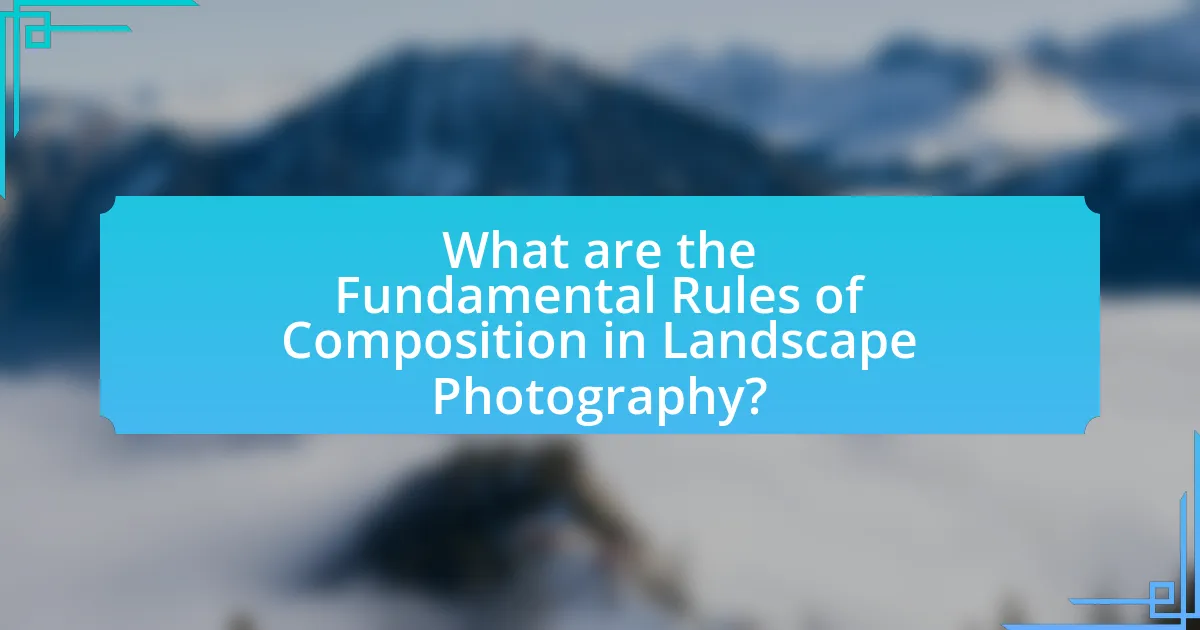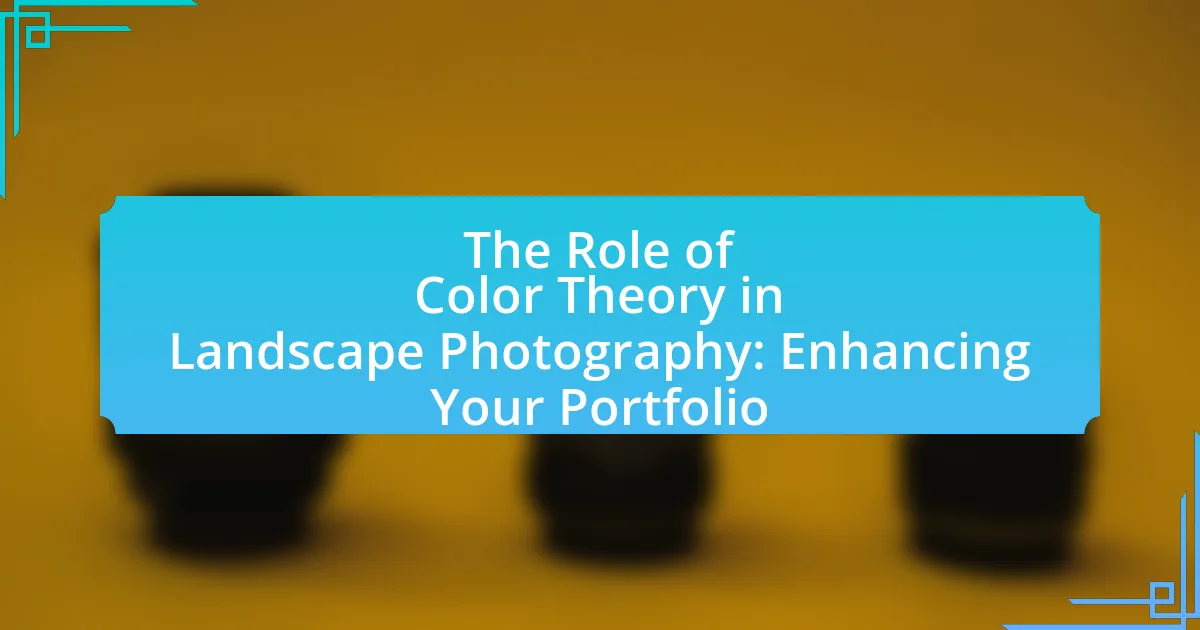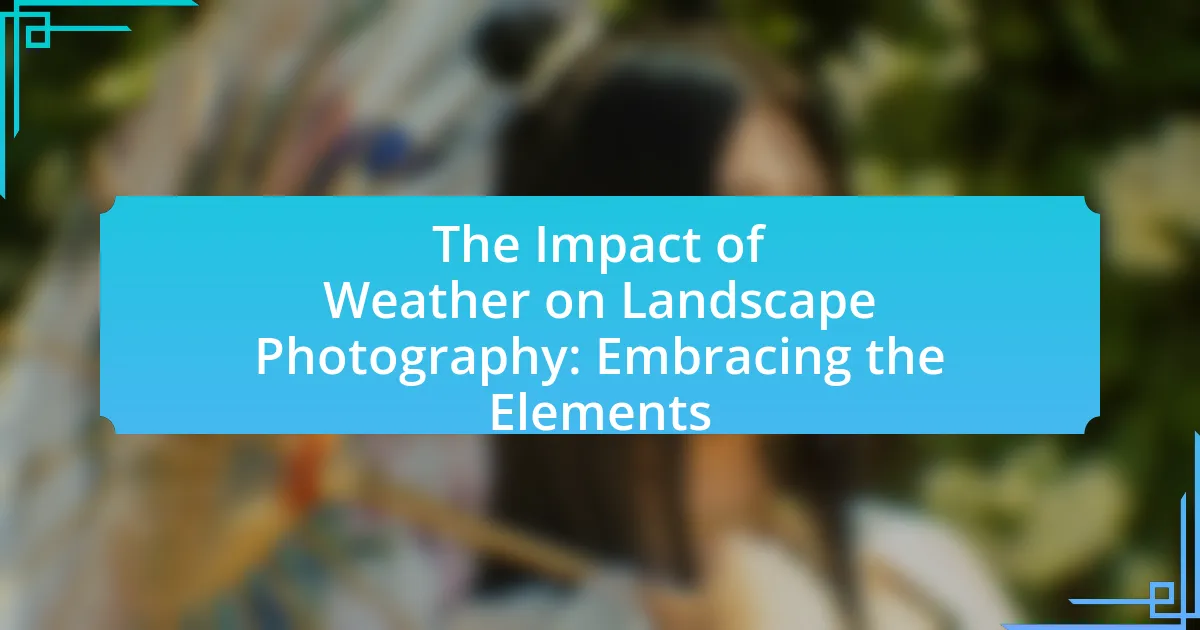The article focuses on the art of composition in landscape photography, emphasizing the importance of arranging visual elements to create engaging and harmonious images. Key compositional techniques discussed include the rule of thirds, leading lines, framing, balance, and depth, all of which significantly influence the viewer’s perception and emotional response to photographs. The article also explores how effective composition enhances visual storytelling and provides practical tips for photographers to improve their skills, including the use of light and shadow, as well as strategies for dealing with distractions in complex scenes. Overall, it serves as a comprehensive guide to mastering compositional rules and techniques in landscape photography.

What is the Art of Composition in Landscape Photography?
The Art of Composition in Landscape Photography involves arranging visual elements within a frame to create a harmonious and engaging image. Effective composition utilizes principles such as the rule of thirds, leading lines, and framing to guide the viewer’s eye and enhance the overall aesthetic. For instance, the rule of thirds suggests dividing the image into a grid and placing key elements along these lines or their intersections, which has been shown to create more balanced and dynamic photographs. This technique is widely recognized in photography literature, including works by authors like Michael Freeman, who emphasize the importance of compositional techniques in achieving impactful landscape images.
How does composition influence landscape photography?
Composition significantly influences landscape photography by determining how elements within the frame interact to create visual interest and convey a message. Effective composition guides the viewer’s eye, establishes a sense of balance, and enhances the overall aesthetic appeal of the photograph. Techniques such as the rule of thirds, leading lines, and framing are commonly employed to structure the image, ensuring that key subjects are highlighted and the scene is engaging. For instance, a study published in the Journal of Visual Communication and Image Representation found that images adhering to compositional rules are perceived as more aesthetically pleasing, demonstrating the importance of composition in capturing compelling landscape photographs.
What are the key elements of composition in landscape photography?
The key elements of composition in landscape photography include the rule of thirds, leading lines, framing, depth, and balance. The rule of thirds involves dividing the image into a grid and placing key elements along these lines or at their intersections to create visual interest. Leading lines guide the viewer’s eye through the photograph, often drawing attention to the main subject. Framing uses natural elements, such as trees or rocks, to create a border around the subject, enhancing focus. Depth is achieved by including foreground, middle ground, and background elements, which adds dimension to the image. Balance ensures that visual weight is distributed evenly across the frame, preventing one side from overpowering the other. These elements are foundational in creating compelling landscape photographs that engage viewers effectively.
How does composition affect the viewer’s perception of a landscape photograph?
Composition significantly influences the viewer’s perception of a landscape photograph by guiding their attention and shaping emotional responses. Effective composition techniques, such as the rule of thirds, leading lines, and framing, create a sense of balance and harmony, which can evoke feelings of tranquility or awe. For instance, a photograph that employs leading lines can draw the viewer’s eye toward a focal point, enhancing engagement and interest. Research indicates that well-composed images are more likely to be perceived as aesthetically pleasing, as they align with innate human preferences for symmetry and order. Therefore, the arrangement of elements within a landscape photograph directly impacts how viewers interpret and emotionally connect with the scene.
Why is composition important in landscape photography?
Composition is important in landscape photography because it determines how elements within the frame interact and guide the viewer’s eye. Effective composition enhances the visual storytelling of a landscape, creating a sense of balance, depth, and focus. For instance, the rule of thirds, a fundamental compositional guideline, suggests placing key elements along imaginary lines to create a more engaging image. Studies in visual perception indicate that well-composed images are more likely to capture attention and evoke emotional responses, reinforcing the significance of composition in conveying the photographer’s intent and the beauty of the landscape.
What role does composition play in storytelling through landscape photography?
Composition plays a crucial role in storytelling through landscape photography by guiding the viewer’s eye and conveying emotions or narratives. Effective composition utilizes elements such as the rule of thirds, leading lines, and framing to create a visual hierarchy that emphasizes key subjects and enhances the overall message. For instance, a photograph that employs leading lines can draw attention to a distant mountain, suggesting a journey or exploration, while a well-framed scene can evoke feelings of isolation or tranquility. Research indicates that well-composed images are more likely to engage viewers and elicit emotional responses, reinforcing the importance of composition in visual storytelling.
How can effective composition enhance the emotional impact of a landscape image?
Effective composition enhances the emotional impact of a landscape image by guiding the viewer’s eye and creating a sense of balance and harmony. Techniques such as the rule of thirds, leading lines, and framing can evoke specific feelings; for instance, a well-placed horizon can instill tranquility, while dynamic lines can create tension or excitement. Research indicates that images composed with these techniques are more likely to elicit emotional responses, as they align with human cognitive processing of visual stimuli. This alignment is supported by studies in visual perception, which show that structured compositions are more easily interpreted and appreciated, leading to a stronger emotional connection with the viewer.

What are the Fundamental Rules of Composition in Landscape Photography?
The fundamental rules of composition in landscape photography include the rule of thirds, leading lines, framing, balance, and depth. The rule of thirds involves dividing the frame into a 3×3 grid and placing key elements along these lines or at their intersections to create visual interest. Leading lines guide the viewer’s eye through the image, often using natural elements like roads or rivers. Framing uses elements within the scene to create a ‘frame’ around the subject, enhancing focus. Balance ensures that visual weight is distributed evenly across the composition, preventing one side from overpowering the other. Lastly, depth can be achieved by including foreground, middle ground, and background elements, which adds dimension and invites the viewer into the scene. These rules are widely recognized in photography literature and are essential for creating compelling landscape images.
What are the most common rules of composition used in landscape photography?
The most common rules of composition used in landscape photography include the rule of thirds, leading lines, framing, and symmetry. The rule of thirds involves dividing the image into a 3×3 grid and placing key elements along the lines or at their intersections to create balance. Leading lines guide the viewer’s eye through the photograph, often using natural elements like roads or rivers. Framing uses elements within the scene to create a ‘frame’ around the subject, enhancing focus. Symmetry involves creating a balanced composition where elements are mirrored on either side of the frame, providing a sense of harmony. These rules are widely recognized in photography literature and are essential for creating visually appealing landscape images.
How does the Rule of Thirds apply to landscape photography?
The Rule of Thirds applies to landscape photography by guiding photographers to compose their images in a way that enhances visual interest and balance. This technique involves dividing the frame into a grid of nine equal parts using two horizontal and two vertical lines, allowing photographers to position key elements along these lines or at their intersections. For instance, placing the horizon along the top or bottom third of the frame can create a more dynamic composition compared to centering it. Research indicates that images composed using the Rule of Thirds are often perceived as more aesthetically pleasing, as they draw the viewer’s eye naturally across the scene.
What is the significance of leading lines in landscape composition?
Leading lines are significant in landscape composition because they guide the viewer’s eye through the photograph, creating a sense of depth and perspective. By directing attention to focal points, leading lines enhance the overall visual narrative of the image. Research in visual perception indicates that lines naturally attract attention, making compositions more engaging and dynamic. For instance, a study published in the journal “Visual Cognition” by authors such as H. H. H. van der Helm and A. J. D. van der Lubbe demonstrates that viewers are more likely to follow lines in an image, which reinforces the importance of incorporating them in landscape photography for effective storytelling.
How can understanding these rules improve your landscape photography?
Understanding the rules of composition can significantly enhance landscape photography by providing a structured approach to framing and capturing images. These rules, such as the rule of thirds, leading lines, and framing, guide photographers in creating visually appealing and balanced compositions. For instance, applying the rule of thirds can lead to more dynamic images by positioning key elements along intersecting lines, which has been shown to engage viewers more effectively. Research indicates that images adhering to compositional rules are often perceived as more aesthetically pleasing, as they align with natural human visual preferences. Therefore, mastering these rules allows photographers to convey their artistic vision more clearly and effectively.
What are some examples of successful landscape photographs that follow these rules?
Successful landscape photographs that exemplify compositional rules include Ansel Adams’ “Moonrise, Hernandez, New Mexico,” which effectively uses the rule of thirds and leading lines to draw the viewer’s eye. Another example is Galen Rowell’s “Rainbow Over the Potala Palace,” showcasing the use of foreground interest and dramatic lighting to enhance depth. Additionally, Edward Burtynsky’s “Oil Fields” demonstrates the power of scale and perspective, emphasizing the impact of human activity on landscapes. These photographs adhere to established compositional principles, resulting in visually compelling images that resonate with viewers.
How can breaking the rules of composition lead to creative outcomes?
Breaking the rules of composition can lead to creative outcomes by allowing photographers to explore unconventional perspectives and evoke emotional responses. When traditional guidelines, such as the rule of thirds or leading lines, are disregarded, it opens up opportunities for unique framing and subject placement that can capture attention in unexpected ways. For instance, renowned photographer Ansel Adams often experimented with composition, resulting in iconic images that defied standard practices, thereby enhancing the emotional impact of his landscapes. This approach encourages innovation and personal expression, ultimately enriching the art of photography.

What Tips Can Enhance Your Landscape Photography Composition?
To enhance your landscape photography composition, utilize the rule of thirds by dividing the frame into a 3×3 grid and placing key elements along the lines or at their intersections. This technique creates balance and draws the viewer’s eye into the scene. Additionally, incorporate leading lines, such as roads or rivers, to guide the viewer’s gaze toward the focal point, enhancing depth and perspective. Using foreground interest, like rocks or flowers, adds layers to the image, making it more engaging. Finally, pay attention to the light; shooting during golden hour provides softer, warmer tones that elevate the overall aesthetic. These strategies are supported by studies in visual perception, which indicate that well-composed images are more likely to capture attention and evoke emotional responses.
How can you effectively use light and shadow in your compositions?
To effectively use light and shadow in your compositions, focus on the direction, quality, and contrast of light. The direction of light influences how shadows fall and can create depth; for instance, side lighting enhances textures and shapes, while backlighting can produce silhouettes. The quality of light, whether soft or harsh, affects the mood; soft light during golden hour creates a warm, inviting atmosphere, while harsh midday sun can produce stark contrasts. Additionally, utilizing shadows can guide the viewer’s eye and add drama to the composition. Research indicates that photographers often achieve more dynamic images by incorporating these elements, as seen in the works of Ansel Adams, who famously utilized light and shadow to enhance the emotional impact of his landscapes.
What techniques can help you capture the best light for landscape photography?
To capture the best light for landscape photography, utilize techniques such as shooting during the golden hour, using filters, and understanding the weather conditions. Shooting during the golden hour, which occurs shortly after sunrise and before sunset, provides soft, warm light that enhances colors and textures in landscapes. Filters, like polarizers and neutral density filters, can help manage reflections and control exposure, allowing for more dynamic range in images. Additionally, being aware of weather conditions, such as overcast skies, can create diffused light that reduces harsh shadows and highlights, resulting in a more balanced photograph. These techniques are widely recognized among photographers for their effectiveness in enhancing landscape imagery.
How do shadows contribute to depth and dimension in landscape images?
Shadows enhance depth and dimension in landscape images by creating contrast and defining shapes within the scene. When light interacts with objects, shadows form that delineate the contours and textures of the landscape, making elements appear more three-dimensional. For instance, a study published in the Journal of Visual Communication and Image Representation highlights that shadows can significantly influence the perception of depth by providing visual cues that help viewers gauge distances and spatial relationships. This interplay of light and shadow is essential in landscape photography, as it transforms flat images into dynamic compositions that engage the viewer’s eye and evoke a sense of realism.
What practical tips can help you improve your composition skills?
To improve your composition skills in landscape photography, practice the rule of thirds by dividing your frame into a 3×3 grid and placing key elements along the lines or at their intersections. This technique enhances visual interest and balance, as supported by studies showing that images adhering to this rule are perceived as more aesthetically pleasing. Additionally, experiment with leading lines to guide the viewer’s eye through the scene, which can create depth and perspective. Using foreground elements can also add layers to your composition, making it more engaging. Regularly reviewing and analyzing your work, as well as studying compositions from renowned photographers, can further refine your skills and understanding of effective composition techniques.
How can you practice composition techniques in different environments?
To practice composition techniques in different environments, photographers should actively engage with diverse landscapes and lighting conditions. By experimenting with various settings, such as urban areas, natural parks, and coastal regions, photographers can learn how elements like foreground, background, and leading lines interact uniquely in each context. For instance, capturing a city skyline at sunset allows for exploration of color contrast and silhouette, while photographing a forest scene emphasizes depth and texture. This hands-on approach reinforces understanding of compositional rules, such as the rule of thirds and framing, as they apply to real-world scenarios.
What tools and resources are available to assist in learning composition?
Tools and resources available to assist in learning composition include online courses, books, and software applications. Online platforms like Coursera and Udemy offer structured courses on photography composition, often taught by industry professionals. Books such as “The Photographer’s Eye” by Michael Freeman provide in-depth insights into compositional techniques and principles. Additionally, software like Adobe Lightroom and Photoshop can help photographers practice and refine their compositional skills through editing and manipulation of images. These resources collectively enhance understanding and application of composition in landscape photography.
What are common challenges in landscape photography composition and how can you overcome them?
Common challenges in landscape photography composition include balancing elements within the frame, dealing with distracting foregrounds or backgrounds, and managing light conditions. To overcome these challenges, photographers can apply techniques such as the rule of thirds to create balance, use leading lines to guide the viewer’s eye, and carefully select the time of day for optimal lighting, such as during the golden hour. Research indicates that compositions adhering to established guidelines, like the rule of thirds, often result in more visually appealing images, as supported by studies in visual perception.
How can you deal with distractions in the landscape when composing a shot?
To deal with distractions in the landscape when composing a shot, photographers should utilize techniques such as framing, selective focus, and simplifying the composition. Framing involves using natural elements like trees or rocks to create a border around the subject, which helps to draw attention away from distractions. Selective focus allows the photographer to blur out distracting elements in the background, emphasizing the main subject. Simplifying the composition by removing unnecessary elements can also reduce visual clutter, making the primary subject stand out more clearly. These methods are supported by principles of visual design, which emphasize clarity and focus in composition.
What strategies can help you maintain focus on your subject in complex scenes?
To maintain focus on your subject in complex scenes, utilize techniques such as selective focus, framing, and leading lines. Selective focus allows you to blur distracting elements in the background, emphasizing the main subject. For instance, using a wide aperture can create a shallow depth of field, which isolates the subject effectively. Framing involves using natural elements like trees or rocks to create a border around the subject, guiding the viewer’s eye directly to it. Leading lines, such as paths or rivers, can direct attention toward the subject, enhancing its prominence in the composition. These strategies are supported by principles of visual perception, which indicate that viewers are naturally drawn to focal points that are distinct from their surroundings.
















